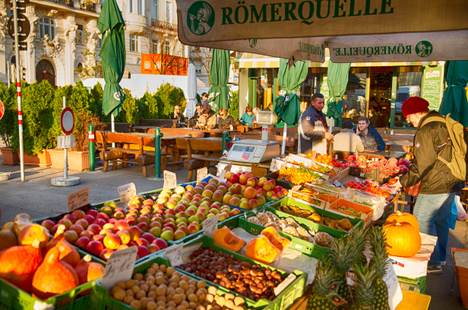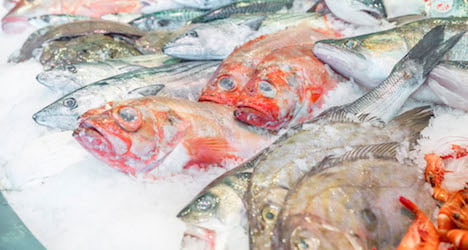We´ve all been there, standing frowning at the checkout of the supermarket with an uninspired basket of junk or processed 'food' wondering why we didn't just order out for a pizza.
Here are some places that are worth a little detour that will help you to cook properly at home, and rekindle the love of tasting something home-made off a wooden spoon…hopefully without burning your tongue.
Meat
The bad news is that most Austrian grocery stores and supermarkets have a sigh-inducing fresh meat range. The good news is that Vienna is liberally littered with great butchers.
Find yourself a local one who's good and stick with them. Chat with your local butcher, a bit of rapport will only lead to great meat.
Our tip is to get your pork, poultry and innards from an Austrian butcher, but hit up your local Turkish butcher for anything beef or lamb related. Most Turkish places will mince meat freshly and cheaply in front of you if you ask.
Making a bolognese? Pick a nice lean piece of meat to be minced.
Making burgers? Make sure there's a nice bit of fat going in; a ratio of twenty percent fat to meat is where the entrance to burger heaven begins.
Places we love include Szabo's and Stanzl's the butchers.
Fleischerei Szabo
Anzengrubergasse 11
1050 Wien
They're also at:
Schönbrunnerstrasse 129
1050 Wien
Open Mon-Thurs 6 am – 1 pm and 3–6 pm,
Fri 6 am – 6 pm, Sat 6 am – 1 pm
http://www.fleischerei-szabo.at
Tel: 01/54 53 908
Friedrich Stanzl
Erbergstraße 83
1030 Wien
Mon-Thurs 7 am – 1:30 pm and 3:30–6:30 pm,
Fri 7 am – 6.30 pm, Sat 7 am – 12 pm
http://www.stanzl-spezialitaeten.at/
Tel.: 01/713 31 30
Fish
You´d think that being landlocked makes fish a terrible option in Austria, and mostly, you're correct. However, a bit of effort and you could close your eyes and believe that you've transported yourself to a far flung coastal town somewhere.
Don´t even consider touching those bloated packs of week old trout you see hidden at the end of the meat counter in supermarkets, they'll turn you off cooking fish for life.
Avoid fish with dull eyes, that is floppy and sad looking. If it smells of fish, forget about it, it's old. Bright eyes, slimy scales, bloody gills and firm tails are what you´re after.
If it´s only the filleted fish for sale, look for near-transparent or opaque fillets, that haven´t been sitting on ice absorbing water all day, otherwise they will stick to your pan and end up soggy when cooked.
Be brave when demanding the freshest fish, they´ll respect you for it.
If you want spanking fresh fish then Eishken Estate is your best bet, a bit of a trek out to them, but well worth the drive.
Eishken Estate
Großgrünmarkt Inzersdorf
Laxenburgerstraße 365, Halle A2, Stand 1-3
1230 Vienna
Mon- Fri 6 am – 1 pm, Sat 7 am – 12 pm
www.eishken.at/index.php
Tel.: 01/889 37 33
Closer to home, and also very very good we have
Umar Fisch
Naschmarkt 76-79
1040 Vienna
Mon–Fri 8 am–6 pm
Sat 8 am – 5 pm
www.umarfisch.at/fischshop.shtml
The fish shop at Lubin imports the fish directly from their own boats in Croatia.
Lubin Fisch
Hainburgerstraße 50
1030 Vienna
Tues-Sat 9 am – 5 pm
Tel: 01/955 67 08
Frische Paradies is also a very safe option.
Sagedergasse 18–22
1120 Vienna
Mon–Wed 8 am – 6 pm / Thu–Fri 8 am – 7 pm /
Sat 8 am – 4 pm.
Vegetables
There are dozens of good markets littered around the capital. Saturday mornings at Naschmarkt in the summer months can be joyous when the sun has brought the best out in fruit and vegetables.
Other great options are rooting out the best stalls at Brunnenmarkt and Karmelitermarkt.
There´s no definite consistency in shopping for fruit'n'veg – play it by ear, ask what's good, wander around, let what´s good dictate what you´ll make for dinner that night.
Our experience of the supermarket chains are that Hofer and Lidl offer the freshest and cheapest fruit and veg, but usually a narrower range than can be found at the markets.

Naschmarkt. Photo: Paul Gillingwater
Naschmarkt
Mon – Fri 6 am – 6:30pm / Saturday 6 am – 5 pm
Saturday mornings is when the farmers and growers bring the local seasonal stuff, get in early, and be prepared for grannies to poke you with umbrellas to get the best fruits and beware the drunkards falling out of Goodman's from the night before.
Brunnenmarkt
The longest street market in Vienna, if you´re looking for trendy and hipster, get out now, but if you're looking for decent fruit and veg, then stick around.
Mon-Fri 6 am – 6:30 pm / Saturday 6 am – 2 pm
Karmelitermarkt
We always go here to buy fruit and spend the day eating at the little places littered around here.
Mon – Fri 6 am – 6.30 pm / 6 am – 5 pm
Bread
You can´t beat tackling the thick heavy crust of real bread, compared to that air-filled tasteless belly-filler that most places have. The bread – and everything else – at Joseph Brot is well worth the journey. For an extra euro a loaf, you can get a real, organic loaf of bread.
Felz at Westbahnoff is great too, and of the chain bakeries, Der Mann is our favourite. Of course you can make your own bread, and we´ll follow up soon with easy and simple bread recipes.
Joseph Brot
Naglergasse 9
1010 Wien
Mon – Fri 7 am – 7 pm /Sat 8 am – 6pm
They also have a second location in the third district:
Joseph Brot
Landstraßer Hauptstraße 4
1030 Vienna
Mon – Sat 6.30 am- 9 pm / Sun 7.30 am – 9 pm.
Felz
Schottenfeldgasse 88A
1070 Vienna
Mon – Fri 6 am – 6.30 pm /Sat 6 am – 5 pm /
Sun 6 am – 12:30 pm
www.felzl.at
Tel 01/5230141
General ingredients
Special mention, for something a bit different, and to really inspire, pop into Prosi's. The range of lovely ingredients is enough to have you whipping out the pots and pans, and they are all round decent people. The little canteen down the back is always full of happy customers. Make sure to grab one of the home-made samosas beside the checkout.
Prosi Exotic Supermarket
Wimbergergasse 5
1070 Vienna
Mon – Sat 9 am – 8 pm
It's scary and depressing to see how food habits are changing, it used to be cost effective to buy and cook home-made food, but these days, and unnervingly so, convenience food is cheaper to buy.
But look where buying €1.39 packets of lasagne got us. Old horse and donkey meat anybody?
An extra euro here and an extra bit of shopping there, and you´ll quickly get into the habit of eating home-made food. Now go forth and cook.
– Gaz



 Please whitelist us to continue reading.
Please whitelist us to continue reading.
Member comments